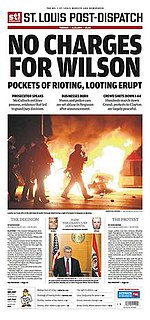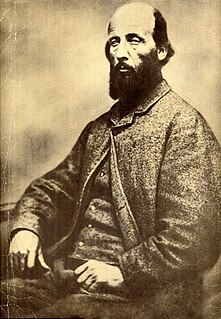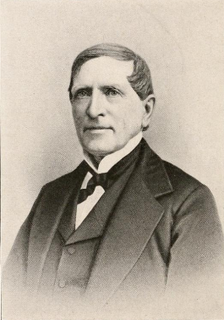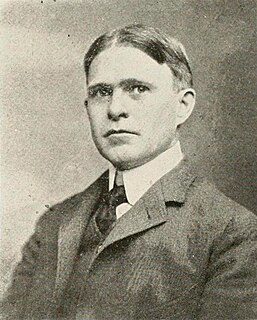
Homestead is a borough in Allegheny County, Pennsylvania, USA, in the Monongahela River valley 7 miles (11 km) southeast of downtown Pittsburgh and directly across the river from the city limit line. The borough is known for the Homestead Strike of 1892, an important event in the history of labor relations in the United States. The population of Homestead was 2,884 at the 2020 census.

The St. Louis Post-Dispatch is a major regional newspaper based in St. Louis, Missouri, serving the St. Louis metropolitan area. It is the largest daily newspaper in the metropolitan area by circulation, surpassing the Belleville News-Democrat, Alton Telegraph, and Edwardsville Intelligencer. The publication has received 19 Pulitzer Prizes.
Vincent C. Schoemehl, Jr. was the 42nd mayor of St. Louis, Missouri, serving three terms from 1981 to 1993. At the time of his first election, he was one of the city's youngest mayors. In 1992, Schoemehl was defeated in the Democratic primary by lieutenant governor Mel Carnahan in a bid to become Governor of Missouri.

Charles Fenerty, was a Canadian inventor who invented the wood pulp process for papermaking, which was first adapted into the production of newsprint. Fenerty was also a poet.
Opera Theatre of Saint Louis (OTSL) is an American summer opera festival held in St. Louis, Missouri. Typically four operas, all sung in English, are presented each season, which runs from late May to late June. Performances are accompanied by the St. Louis Symphony Orchestra, which is divided into two ensembles, each covering two of the operas, for the season. The company's performances are presented in the Loretto-Hilton Center for the Performing Arts on the campus of Webster University.
Sports Time was a regional sports network in the United States of America. It was owned by a limited partnership headed by Anheuser-Busch and was launched on April 2, 1984. Sports Time was available in 15 states from Colorado to West Virginia.

The Danforth Campus is the main campus at Washington University in St. Louis. Formerly known as the Hilltop Campus, it was officially dedicated as the Danforth Campus on September 17, 2006, in honor of William H. Danforth, the 13th Chancellor of the University, the Danforth family and the Danforth Foundation. Distinguished by its collegiate gothic architecture, the 169-acre (0.68 km2) campus lies at the western boundary of Forest Park, partially in the City of St. Louis. Most of the campus is in a small enclave of unincorporated St. Louis County, while all the campus area south of Forsyth Boulevard is in suburban Clayton. Immediately to the north across Forest Park Parkway is University City.

Midtown is a neighborhood in St. Louis, Missouri. It is located 3 miles (4.8 km) west of the city riverfront at the intersection of Grand and Lindell Boulevards. It is home to the campus of Saint Louis University and the Grand Center Arts District.
Mercantile Bancorporation was the largest bank holding company in Missouri when it was acquired by Firstar Corporation in 1999.

Henry Overstolz was the 24th mayor of St. Louis, Missouri, serving from 1876 to 1881. He was a direct descendant of the oldest patrician family of Cologne, Germany. He exerted a wide influence on public thought and action, upon political affairs and business activity.
This is a list of properties and historic districts on the National Register of Historic Places within the city limits of St. Louis, Missouri, south of Interstate 64 and west of Downtown St. Louis. For listings in Downtown St. Louis, see National Register of Historic Places listings in Downtown and Downtown West St. Louis. For those north of I-64 and west of downtown, see National Register of Historic Places listings in St. Louis north and west of downtown. For listings in St. Louis County and outside the city limits of St. Louis, see National Register of Historic Places listings in St. Louis County, Missouri.

Sugarloaf Mound is the sole remaining Mississippian culture platform mound in St. Louis, Missouri, a city commonly referred to in its earlier years as "Mound City" for its approximately forty Native American earthen structures.
This is a list of properties and historic districts within the Downtown St. Louis and Downtown West, St. Louis areas of the city of St. Louis, Missouri that are listed on the National Register of Historic Places. The downtown area is defined by Cole Street to the north, the river front to the east, Chouteau Avenue to the south, and Jefferson Avenue to the west. Tucker Avenue divides Downtown to the east from Downtown West to the west.
Frank G. Pellegrino was an American engineer, inventor, and industrialist. He served as president of the General Fibre Company. During his tenure, General Fibre became the largest manufacturer of duck decoy models in the United States, producing over a million per year in the 1950s. Pellegrino also negotiated the sale of the International Hat Company to Interco, Inc. Additionally, he created a variety of inventions related to the plastic molding industry. Most notably, Pellegrino invented automated assembly line machines in the formation of plastic objects. These machines were used by General Fibre in the production of a variety of plastic models, duck decoys, and Michelob paraphernalia throughout the 1960s to 1980s.

James P. "Jim" Kavanaugh is an American businessman serving as the CEO of World Wide Technology.

Augustus Frederick Shapleigh (1810–1902) was an American businessman and early pioneer of St. Louis during the Second Industrial Revolution. He was president of the A. F. Shapleigh Hardware Company, which by the 1880s grew to be one of the largest wholesale hardware firms west of the Mississippi River. He was also involved in a number of other business endeavors in the banking, mining, and insurance industry.

Takuma Kajiwara was a Japanese-born American artist who was called "one of the seven greatest photographers in the United States".

Walter C. Root was an American architect practicing in Kansas City, Missouri. He is best known for his major works in Missouri and Kansas, including Dyche Hall on the University of Kansas campus.

Mill Creek Valley was a historic neighborhood located in the central corridor between 20th Street and Saint Louis University in St. Louis, Missouri. European settlement began in the 18th century with mills established along La Petite Rivière, now known as Mill Creek. It became an industrial and railroad center in the 19th century. Union Station was opened in 1894. The building was closed in 1978 and renovated for commercial use. Also a residential and commercial center, Mill Creek Valley was populated by German immigrants and African Americans, before and after the Civil War. More people moved into the area during World War II to support the war effort.













